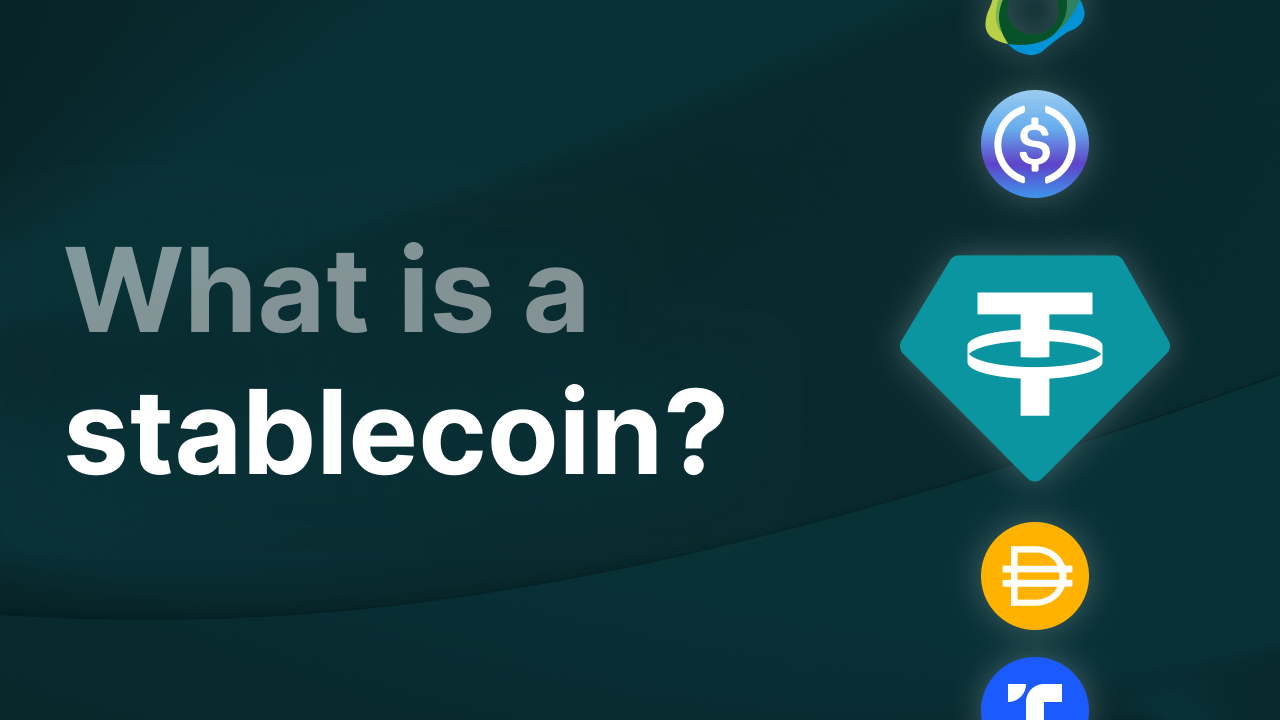What is a Stablecoin?

The cryptocurrency world has been evolving rapidly, and among its many innovations, stablecoins have emerged as a significant player. In an environment where volatility is often the norm, stablecoins offer a semblance of stability, making them an attractive option for both investors and everyday users. This article delves into the intricacies of stablecoins, explaining what they are, how they work, and highlighting the best stablecoins, including Euro stablecoins.
Key Takeaways
- Stablecoins are a form of cryptocurrency designed to maintain a stable value by being pegged to another asset, like a fiat currency or gold.
- They aim to offer a solution to the volatility seen in cryptocurrencies, making them more appropriate for everyday transactions.
- Stablecoins can be employed in a range of blockchain-based financial services and can also be used for purchasing goods and services.
Understanding Stablecoins
Stablecoins are a type of cryptocurrency designed to minimize price fluctuations. Unlike traditional cryptocurrencies like Bitcoin or Ethereum, which can experience price swings, stablecoins aim to maintain a stable value relative to a specific asset or basket of assets. This stability is typically achieved through various mechanisms, including pegging the stablecoin to a fiat currency like the US dollar or the Euro.
Types of Stablecoins
There are several types of stablecoins, each with its unique approach to achieving stability. The main categories are fiat-collateralized stablecoins, crypto-collateralized stablecoins, algorithmic stablecoins and commodity-backed stablecoins.
Fiat-Collateralized Stablecoins
These stablecoins are backed by a reserve of fiat currency, such as USD or EUR, held in a bank account. For every unit of the stablecoin issued, an equivalent amount of fiat currency is held in reserve. This ensures that the stablecoin can be redeemed for the fiat currency at any time, maintaining its stable value. Examples include:
- Tether (USDT): One of the most well-known stablecoins, backed by US dollars.
- USD Coin (USDC): Another popular dollar-pegged stablecoin with transparent audits.
- EURC: A euro-backed stablecoin that’s accessible globally on Avalanche, Ethereum, Solana, and Stellar. Similar to USDC, EURC is issued by Circle under a full-reserve model.
Crypto-Collateralized Stablecoins
These stablecoins are backed by other cryptocurrencies rather than fiat currency. To account for the volatility of the collateral, these stablecoins are often over-collateralized. This means that the value of the cryptocurrency held in reserve exceeds the value of the stablecoins issued. Examples include:
- Dai (DAI): Managed by the MakerDAO system and backed by Ethereum and other crypto assets.
- sUSD: A synthetic stablecoin backed by Synthetix Network tokens.
Algorithmic Stablecoins
These stablecoins rely on algorithms and smart contracts to maintain their stability. Instead of being backed by collateral, they use algorithms to control the supply of the stablecoin, buying or selling assets to stabilize the price. Examples include:
- Ampleforth (AMPL): Adjusts its supply daily to match demand, keeping its price stable.
- TerraUSD (UST): TerraUSD was an algorithmic stablecoin for the Terra Luna network. It used a dual-token system to maintain its peg.
Commodity-Backed Stablecoins
Commodity-backed stablecoins are secured with physical assets such as precious metals, oil, and real estate. Gold is the most commonly used commodity for collateral, with Tether Gold (XAUT) and Paxos Gold (PAXG) being two of the most liquid gold-backed stablecoins.
- Tether Gold (XAUT): A digital token, backed by physical gold.
- Paxos Gold (PAXG): PAXG is a digital asset that represents physical gold stored in a vault, each token representing one troy ounce of a 400 oz London Good Delivery gold bar.
Why Stablecoins Matter
Stablecoins play a crucial role in the cryptocurrency ecosystem for several reasons:
- Reducing Volatility: Stablecoins provide a safe haven for investors during periods of high market volatility. They allow users to move funds quickly without converting back to fiat currency.
- Facilitating Transactions: Stablecoins make it easier to conduct everyday transactions using cryptocurrency, as their value remains relatively stable.
- Access to DeFi: Decentralized Finance (DeFi) platforms often use stablecoins for lending, borrowing, and earning interest, offering a stable medium of exchange within the ecosystem.
- Cross-Border Payments: Stablecoins can facilitate faster and cheaper cross-border payments compared to traditional banking systems.
The Rise of Euro Stablecoins
While many stablecoins are pegged to the US dollar, there is a growing interest in Euro stablecoins. These stablecoins offer similar benefits but are pegged to the Euro, providing an alternative for users and businesses operating in the Eurozone. Examples of Euro stablecoins include:
- Stasis Euro (EURS): One of the most prominent euro stablecoins, backed by euro reserves and offering transparency through regular audits.
- sEUR: A synthetic euro stablecoin issued by the Synthetix Network.
- EURC: A euro-backed stablecoin that’s issued by Circle under a full-reserve model.
Euro stablecoins provide additional benefits such as:
- Hedging Against Currency Risk: For individuals and businesses in the Eurozone, Euro stablecoins help mitigate the risk associated with exchange rate fluctuations between the Euro and other currencies.
- Integration with European Financial Systems: Euro stablecoins can integrate more seamlessly with European financial services, making them a convenient option for local transactions.
Choosing the Best Stablecoin
With numerous stablecoins available, selecting the best stablecoin depends on individual needs and preferences. Here are some factors to consider when choosing a stablecoin:
Stability and Trustworthiness
- Look for stablecoins with transparent reserves and regular audits to ensure they are fully backed by the pegged asset.
- Consider the issuer's reputation and the regulatory environment in which the stablecoin operates. This is especially important in Europe with the Markets in Crypto-Assets Regulation (MiCA). Circle, the issuer of the popular stablecoins USD Coin (USDC) and EURC, is the first global stablecoin issuer to comply with MiCA.
Liquidity
- High liquidity ensures that you can easily buy and sell the stablecoin without significant price fluctuations.
- Popular stablecoins like USDT and USDC generally offer high liquidity.
Use Case
- Determine your primary use for the stablecoin. If you need it for everyday transactions, a widely accepted stablecoin like USDC or DAI might be ideal.
- For DeFi activities, look for stablecoins that are well-integrated with DeFi platforms.
Regulation and Compliance
- Consider stablecoins issued by entities compliant with regulatory standards to ensure greater security and legal protection.
Fees
- Evaluate the transaction fees associated with using the stablecoin, especially if you plan on making frequent transfers.
The Future of Stablecoins
The stablecoin market is poised for significant growth as more individuals and institutions recognize their potential. Central banks are also exploring Central Bank Digital Currencies (CBDCs), which could further legitimize and expand the use of stablecoins.
Key trends to watch in the stablecoin space include:
- Regulatory Developments: Governments worldwide are paying closer attention to stablecoins, and future regulations will likely impact their issuance and use.
- Technological Advancements: Innovations in blockchain technology and smart contracts will enhance the efficiency and security of stablecoins.
- Integration with Traditional Finance: As stablecoins gain acceptance, they will increasingly integrate with traditional financial systems, offering more seamless interactions between crypto and fiat currencies.
- Expansion of Euro Stablecoins: With the growing interest in Euro stablecoins, we can expect more options and greater adoption within the Eurozone.
Conclusion
Stablecoins have emerged as a pivotal component of the cryptocurrency landscape, offering a bridge between the volatile world of cryptocurrencies and the stability of traditional fiat currencies. Whether used for trading, everyday transactions, or accessing DeFi services, stablecoins provide a reliable and efficient alternative to traditional financial systems.
As the market continues to evolve, staying informed about the latest developments and trends in stablecoins, including Euro stablecoins and the best stablecoin options, will be essential for anyone looking to navigate the digital economy effectively. Whether you're an investor, a business owner, or a crypto enthusiast, understanding stablecoins will empower you to make better financial decisions in the ever-changing world of cryptocurrencies.
